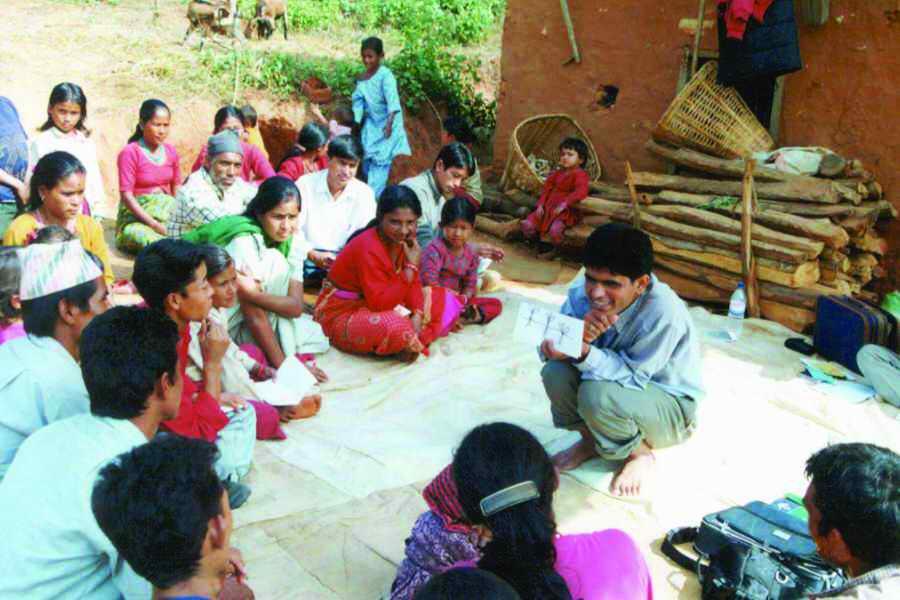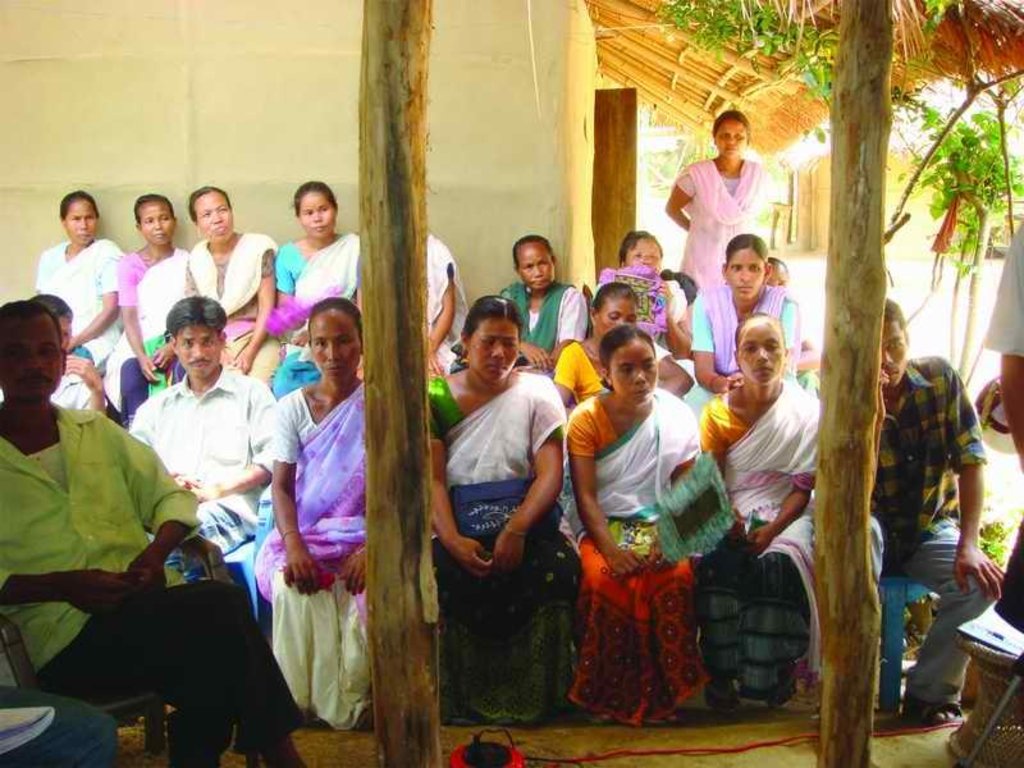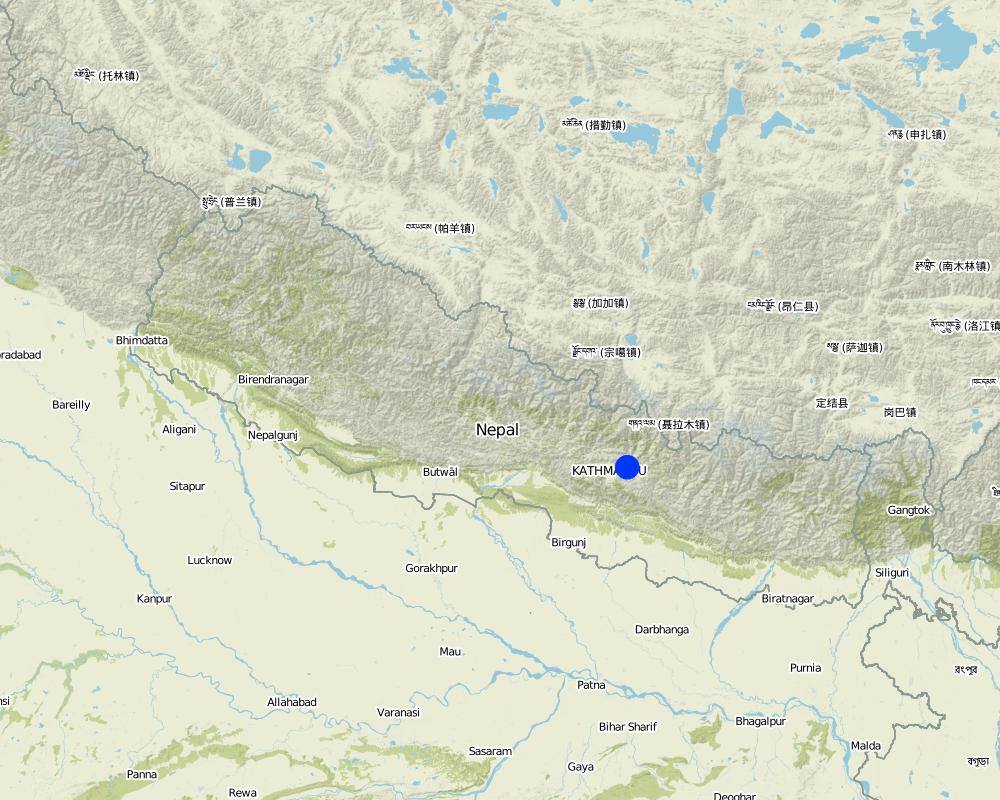Improving terraces with farmers [เนปาล]
- ผู้สร้างสรรค์:
- การอัพเดท:
- ผู้รวบรวม: Madhav Dhakal
- ผู้เรียบเรียง: –
- ผู้ตรวจสอบ: Laura Ebneter
Kisansangai gara sudhar (Nepali)
approaches_2549 - เนปาล
ดูส่วนย่อย
ขยายทั้งหมด ย่อทั้งหมด1. ข้อมูลทั่วไป
1.2 รายละเอียดที่ติดต่อได้ของผู้รวบรวมและองค์กรที่เกี่ยวข้องในการประเมินและการจัดเตรียมทำเอกสารของแนวทาง
ผู้เชี่ยวชาญ SLM:
ชื่อของโครงการซึ่งอำนวยความสะดวกในการทำเอกสารหรือการประเมินแนวทาง (ถ้าเกี่ยวข้อง)
ICIMOD International Centre for Integrated Mountain Development (ICIMOD) - เนปาล1.3 เงื่อนไขที่เกี่ยวข้องกับการใช้ข้อมูลที่ได้บันทึกไว้ผ่านทาง WOCAT
ผู้รวบรวมและวิทยากรหลักยอมรับเงื่อนไขเกี่ยวกับการใช้ข้อมูลที่ถูกบันทึกผ่านทาง WOCAT:
ใช่
2. คำอธิบายของแนวทาง SLM
2.1 การอธิบายแบบสั้น ๆ ของแนวทาง
Participatory action research with multiple stakeholders for the demonstration and extension of improved rainfed hill terraces in Nepal
2.2 การอธิบายอย่างละเอียดของแนวทาง
การอธิบายอย่างละเอียดของแนวทาง:
The traditional farming practices employed on steep sloping land in Kubinde village in Nepal's midhills led to soil and water erosion and low crop and fodder yields. The People and Resource Dynamics in Mountain Watersheds of the Hindu Kush- Himalayas Project (PARDYP) started work in 2001, with a small group of farmers from this village (who were also members of the local forest user group) and the Department of Soil Conservation and Watershed Management to identify and test an integrated approach for addressing these constraints. The approach taken was an improved hill terrace for rainfed conditions consisting of structural and vegetative measures. The aim was to demonstrate and test the technologies' potential for overcoming constraints related to farming sloping agricultural land. The specific objectives were, in association with the local farmers, to design a technology that solved soi erosion problems on sloping agricultural lands whilst at the same time increasing the land's nutrient conservation and production capacity. The local line agency office of the Department of Soil Conservation and Watershed Management was involved in developing the technology to make use of their experiences and to come up with a validated technology that the department could use in its own programmes.
Before implementing the terrace improvement work in Kubinde village, a terrace improvement committee was formed made up of local farmers. The awareness activities began in January 2001. Committee members were trained on subwatershed management and were taken to the International Centre for Integrated Mountain Development’s (ICIMOD) Demonstration and Training Centre at Godavari and another ICIMOD site to show them potential soil and water conservation technologies including improved terraces. After the technologies were implemented, a number of farmer exchange, interaction and monitoring programmes were held to assess the technology and to promote it. Indicators were developed for monitoring the activity.
About half of the costs were covered by the participating farmers and the rest by PARDYP. The other incentives were training and extension, allowances for participants, national expert honoraria, and training material such as audio-visual facilities. These were all provided by PARDYP with the help of the line agency.
2.3 รูปภาพของแนวทาง
2.5 ประเทศ ภูมิภาค หรือสถานที่ตั้งที่ได้นำแนวทางไปใช้
ประเทศ:
เนปาล
ข้อมูลเฉพาะเพิ่มเติมของสถานที่ตั้ง:
kavre Palanchok/ Kubinde village, Jhikhu Khola watershed
Map
×2.6 วันที่เริ่มต้นและสิ้นสุดของแนวทาง
การสิ้นสุดลง (ถ้าแนวทางไม่ได้ใช้อีกต่อไป):
2005
2.7 ประเภทของแนวทาง
- ใช้โครงงานหรือแผนงานเป็นฐาน
2.8 เป้าหมายหรือวัตถุประสงค์หลักของแนวทาง
Local farmers collectively solving problems by identifying and using the most appropriate local solutions. Local farmers designing, testing, and disseminating alternative technologies adapted to local conditions. Strengthening joint learning by farmers and development actors
The SLM Approach addressed the following problems: Weak institutional collaboration for addressing 1) poor soil fertility and land productivity; 2) soil and nutrient loss and excessive water runoff from sloping agricultural land; and 3) fodder scarcity. Lack of on-farm research for developing technologies that attend to farmers' needs.
2.9 เงื่อนไขที่เอื้ออำนวยหรือเป็นอุปสรรคต่อการนำเทคโนโลยีภายใต้แนวทางนี้ไปปฏิบัติใช้
การมีไว้ให้หรือการเข้าถึงแหล่งการเงินและบริการ
- เป็นอุปสรรค
Government incentives are lacking
Treatment through the SLM Approach: The technology is cost effective.
การจัดตั้งระดับองค์กร
- เป็นอุปสรรค
Lack of coordination among land users
Treatment through the SLM Approach: Terrace improvementuser group formed
กรอบแนวทางในการดำเนินการด้านกฎหมาย (การถือครองที่ดิน สิทธิในการใช้ที่ดินและน้ำ)
- เอื้ออำนวย
The existing land ownership, land use rights / water rights greatly helped the approach implementation: Because of private land ownership, there were no conflicts and hence the technology for deissmeination was well maintained.
ความรู้เกี่ยวกับ SLM การเข้าถึงการสนับสนุนด้านเทคนิค
- เป็นอุปสรรค
It is not a priority area of line agencies
Treatment through the SLM Approach: The appraoch relies on farmer adoption
อื่นๆ
- เป็นอุปสรรค
lack of awareness
Treatment through the SLM Approach: Trainings , discussions and field visits
3. การมีส่วนร่วมและบทบาทของผู้มีส่วนได้ส่วนเสียที่เกี่ยวข้อง
3.1 ผู้มีส่วนได้ส่วนเสียที่เกี่ยวข้องในแนวทางนี้และบทบาท
- ผู้ใช้ที่ดินระดับท้องถิ่นหรือชุมชนระดับท้องถิ่น
Men and women land users worked equally
- ผู้เชี่ยวชาญ SLM หรือที่ปรึกษาการเกษตร
- ครู เด็กนักเรียน หรือนักศึกษา
- องค์กรพัฒนาเอกชน
- รัฐบาลระดับท้องถิ่น
- รัฐบาลแห่งชาติ (ผู้วางแผน ผู้ทำการตัดสินใจ)
- health volunteers
3.2 การเกี่ยวข้องของผู้ใช้ที่ดินระดับท้องถิ่นหรือชุมชนระดับท้องถิ่นในช่วงต่างๆของแนวทาง
| ความเกี่ยวข้องของผู้ใช้ที่ดินระดับท้องถิ่นหรือชุมชนระดับท้องถิ่น | ระบุผู้ที่มีส่วนเกี่ยวข้องและอธิบายกิจกรรม | |
|---|---|---|
| การริเริ่มหรือการจูงใจ | ไม่ลงมือ | Group discussion; organised with local forest user group; selection of members for training and tours (12 men and 11 women); formation of terrace improvement committee. |
| การวางแผน | ปฏิสัมพันธ์ | group discussion; survey , site selection , fodder / grass species selection |
| การดำเนินการ | ระดมกำลังด้วยตนเอง | Terracing activities: measurement, soil excavation, and retaining wall construction |
| การติดตามตรวจสอบหรือการประเมินผล | ปฏิสัมพันธ์ | Done in a participatory way involving individual farmers, project staff, and Department of Soil Conservation staff |
| Research | ไม่ลงมือ | Assessing performance of planted grasses and advantages and disadvantages of technology |
3.3 แผนผังแสดงขั้นตอนการทำงาน (ถ้ามี)
3.4 การตัดสินใจเลือกใช้เทคโนโลยี SLM
ระบุผู้ที่ทำการตัดสินใจเลือกเทคโนโลยีมากกว่าหนึ่งวิธีไปปฏิบัติใช้:
- ผู้เชี่ยวชาญ SLM เป็นผู้ตัดสินใจหลัก ที่ติดตามให้คำปรึกษากับผู้ใช้ที่ดิน
การอธิบาย:
The package was initially offered by researchers and later modified and implemented by land users.
Decisions on the method of implementing the SLM Technology were made by mainly by land users supported by SLM specialists. The landusers are more familiar with their land's capacity and charcteristics.
4. การสนับสนุนด้านเทคนิค การสร้างขีดความสามารถ และการจัดการด้านความรู้
4.1 การสร้างขีดความสามารถ / การอบรม
ได้มีการจัดอบรมให้แก่ผู้ใช้ที่ดินหรือผู้มีส่วนได้ส่วนเสียคนอื่น ๆ หรือไม่:
ใช่
ให้ระบุว่าใครเป็นผู้ได้รับการอบรม:
- ผู้ใช้ที่ดิน
- extensionists/trainers, teachers, school children/students, politicians/decision makers, Health volu
รูปแบบการอบรม:
- เกษตรกรกับเกษตรกร
- ใช้พื้นที่ทำการสาธิต
- จัดคอร์ส
รูปแบบการอบรม:
- Audio vidual learning
หัวข้อที่พูด:
Importance of Soil and Water conservation in local level, concept of sub watershed management, activities in other parts of a country regarding SLM, etc.
4.2 การบริการให้คำแนะนำ
ผู้ใช้ที่ดินมีการเข้าถึงการรับบริการให้คำปรึกษาหรือไม่:
ใช่
การอธิบาย/แสดงความคิดเห็น:
Name of method used for advisory service: Demnstration/extension of improved terrace technology;
Key elements: Participatory Action Research, Trainigs and Farmer to Farmer visits, Particpatory monitoring and evaluation; 1) Advisory service was carried out through: projects own extension structure and agents, government's existing extension system; Extension staff: project employees, govt. staff and farmers. 2) Target groups for extension: land users, technicians/SLM specialists; Activities: Farmer to farmer exchange, demonstration, trainings; Invited to trainigs, field visits
Advisory service is quite adequate to ensure the continuation of land conservation activities; Various extension service agencies have secured funding for SLM programmes.
4.3 การเสริมความแข็งแกร่งให้กับสถาบัน (การพัฒนาองค์กร)
สถาบันได้รับการจัดตั้งขึ้นมาหรือเสริมความแข็งแกร่งโดยแนวทางนี้หรือไม่:
- ไม่
4.4 การติดตามตรวจสอบและประเมินผล
การติดตามตรวจสอบและประเมินผลเป็นส่วนหนึ่งของแนวทางหรือไม่:
ใช่
ความคิดเห็น:
bio-physical aspects were ad hoc monitored through observations; indicators: plant heigth, biomass production, usefulness of grass/fodder species
technical aspects were ad hoc monitored by project staff through observations; indicators: views about technology
socio-cultural aspects were ad hoc monitored through observations; indicators: species selection, change of agricultural practices
economic / production aspects were ad hoc monitored through observations; indicators: changes in crop yields and patterns and the value of the land
area treated aspects were ad hoc monitored through observations; indicators: survey, on-site verifications
land users involved aspects were ad hoc monitored through observations; indicators: survey, number of land users applying for SWC
management of Approach aspects were ad hoc monitored through observations; indicators: maintenance of terraces and hedgerows
There were few changes in the Approach as a result of monitoring and evaluation: New ideas have been generated but strategies to implement them are yet to be in place.
There were few changes in the Technology as a result of monitoring and evaluation: New varieties of grass, fruit and fodder species have been introduced
4.5 การวิจัย
การวิจัยเป็นส่วนหนึ่งของแนวทางหรือไม่:
ใช่
ระบุหัวข้อเรื่อง:
- สังคมวิทยา
- นิเวศวิทยา
- เทคโนโลยี
ให้ข้อมูลเพิ่มเติมและให้ระบุผู้ทำการวิจัย:
Sociology: Looking at scaling up process; Ecology: Looking at the impacts of the technology at subwatershed level; Technology: development process.
Research was carried out on-farm
5. การสนับสนุนด้านการเงินและวัสดุอุปกรณ์
5.1 ระบุงบประมาณประจำปีสำหรับแนวทาง SLM นี้
ถ้าหากว่างบประมาณประจำปีไม่เป็นที่ทราบแน่นอน ให้ระบุช่วงลงไป:
- < 2,000
แสดงความคิดเห็น (แหล่งของการระดมทุน ผู้บริจาคคนสำคัญ):
Approach costs were met by the following donors: national non-government (SDC, IDRC, ICIMOD): 65.0%; local community / land user(s) (Terrace improvement committee): 35.0%
5.2 การสนับสนุนด้านการเงิน / วัสดุอุปกรณ์ให้แก่ผู้ใช้ที่ดิน
ผู้ใช้ที่ดินได้รับการสนับสนุนด้านการเงิน / วัสดุอุปกรณ์ไปปฏิบัติใช้เทคโนโลยีหรือไม่:
ใช่
5.3 เงินสนับสนุนสำหรับปัจจัยนำเข้า (รวมถึงแรงงาน)
- การเกษตร
| ระบุปัจจัยนำเข้าที่ได้รับการสนับสนุน | เห็นด้วยระดับไหน | ระบุเงินสนับสนุน |
|---|---|---|
| เมล็ด | ได้รับการช่วยเหลือทางการเงินแบบเต็ม | |
ถ้าแรงงานโดยผู้ใช้ที่ดินเป็นปัจจัยนำเข้าที่มีอยู่มากมาย ระบุด้วยว่าเนื่องจาก:
- จ่ายเป็นเงินสด
ความคิดเห็น:
About 50% of total labour costs were met by land users.
5.4 เครดิต
มีการจัดหาเครดิตมาให้ภายใต้แนวทาง SLM หรือไม่:
ไม่ใช่
6. การวิเคราะห์ผลกระทบและการสรุป
6.1 ผลกระทบของแนวทาง
ช่วยให้ผู้ใช้ที่ดินนำเอาเทคโนโลยี SLMไปใช้และบำรุงรักษาสภาพไว้ได้หรือไม่:
- ไม่ใช่
- ใช่ เล็กน้อย
- ใช่ ปานกลาง
- ใช่ อย่างมาก
Area expanded , about 100 percent of previously improved terraces was expanded. New variety of grass/ fodder species has been adopted..
Did other land users / projects adopt the Approach?
- ไม่ใช่
- ใช่ เล็กน้อย
- ใช่ ปานกลาง
- ใช่ อย่างมาก
The project's aim was not to promote the approach but the technology. However, similar appraches are followed by other programs as well from before; such as the District Soil Conservation Offices.
6.2 แรงจูงใจหลักของผู้ใช้ที่ดินเพื่อที่จะนำ SLM ไปปฏิบัติใช้
- การผลิตที่เพิ่มขึ้น
increased production (grain and biomass) due to moisture and nutrient conervation
- กำไร (ความสามารถ) อัตราส่วนค่าใช้จ่ายต่อผลประโยชน์ที่เพิ่มขึ้น
Increased land prize
- ภาระงานลดลง
fodder/ grass availability ( near to house)
- การปรับปรุงด้านสุทรียภาพ
greenary throughout the season due to fodder and grass species.
- environmental consciousness, moral, health
less soil erosion from the land
6.3 ความยั่งยืนของกิจกรรมของแนวทาง
ผู้ใช้ที่ดินสามารถทำให้สิ่งต่างๆ ที่ได้ปฏิบัติใช้โดยแนวทางนี้ยั่งยืนได้หรือไม่ (โดยไม่มีการสนับสนุนจากภายนอก):
- ใช่
ถ้าตอบว่าใช่ ให้อธิบายว่าอย่างไร :
More than 60% of the total improved terraces in Kubinde village were built by the land users themselves. Widespread rapid adoption did not happen in other villages due to financial and labour limitations. Land users of Kubinde village continue to maintain the improved terraces.
6.4 จุดแข็งและข้อได้เปรียบของแนวทาง
| จุดแข็ง / ข้อได้เปรียบของแนวทางในทัศนคติของผู้ใช้ที่ดิน |
|---|
| Technical knowledge and confidence increased from the training and field visits, interactions, and experience sharing (How to sustain/ enhance this strength: Such activities should be continued by incorporating other new ideas) |
| The approach led to the development of a team spirit among farmers (How to sustain/ enhance this strength: As above) |
| จุดแข็ง / ข้อได้เปรียบของแนวทางในทัศนคติของผู้รวบรวมหรือวิทยากรหลัก |
|---|
| The approach is based on building the capacity of farmers (both men and women) by involving multiple stakeholders in the development and adoption of the technology. (How to sustain/ enhance this strength: Approach should be to strengthen land users' involvement in SWC activities) |
6.5 จุดอ่อน / ข้อเสียเปรียบของแนวทางและวิธีในการแก้ไข
| จุดอ่อน / ข้อเสียเปรียบในทัศนคติของผู้รวบรวมหรือวิทยากรหลัก | สามารถแก้ไขปัญหาได้อย่างไร |
|---|---|
| Due to the conflict, which was on-going at the time, follow-up after a year of implementing technology was not possible and the monitoring was not done. This resulted in the adoption of the technology by other farmers not being carried out properly with, for example, farmers not maintaining the hedgerows as recommended. Also, the new terraces were not as good as they should have been. | The technical experts need to visit the sites and identify gaps and encourage farmers to 'fill them'. For example, the benefit of hedgerow management needs to be demonstrated. |
7. การอ้างอิงและการเชื่อมต่อ
7.1 วิธีการหรือแหล่งข้อมูล
- ไปเยี่ยมชมภาคสนาม การสำรวจพื้นที่ภาคสนาม
- การสัมภาษณ์กับผู้ใช้ที่ดิน
7.2 การอ้างอิงถึงสิ่งตีพิมพ์
ชื่อเรื่อง ผู้เขียน ปี ISBN:
Mathema, P. (2003) Watershed Management in South Asia. Kathmandu: Government of Nepal, Department of Soil Conservation and Watershed Management
ช่องทางในการสืบค้น และราคา:
Department of soil conservation, Nepal
ลิงก์และโมดูล
ขยายทั้งหมด ย่อทั้งหมดลิงก์
ไม่มีลิงก์
โมดูล
ไม่มีโมดูล






